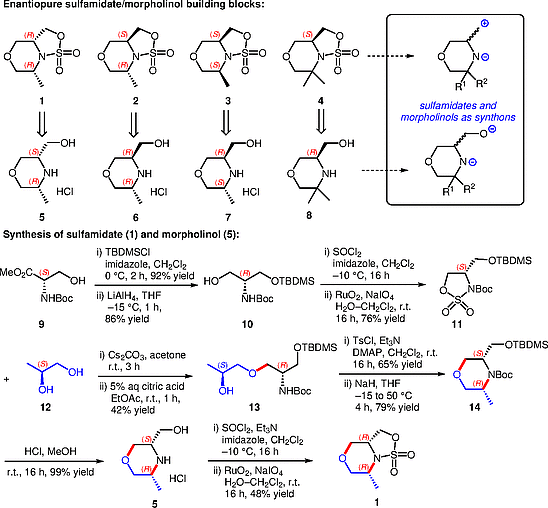
Synthesis of Versatile Enantiopure Morpholine Fragments from Chiral-Pool Starting Materials
Contributors: Paul Richardson (Pfizer)
Significance
The favorable physicochemical properties of morpholines make them attractive motifs for incorporation into bioactive molecules, often as bioisosteric replacements for piperidines; this is a common strategy owing, not only to the lower basicity of the nitrogen, but also because the CYP-mediated degradation of the morpholine ring often leads to nontoxic metabolites. The current report describes methods for synthesizing enantiopure functionalized morpholine fragments, with the 3-hydroxymethylmorpholines 5–8 featuring two nucleophilic groups, whereas the corresponding sulfamidates 1–4 can be viewed as aziridine equivalents and used in annulation reactions for the introduction of morpholine moieties.
Comment
The integral stereochemistry of the desired building blocks is imparted through appropriate selection of readily available enantiopure starting materials specifically derived from Boc-protected serine (e.g., 9) or 1,2-propanediol (e.g., 12). Optimization studies involving the selection of a suitable base–solvent combination were carried out for the critical ring opening of the cyclic sulfamidate 11 with diol 12; aqueous citric acid was used to cleave the resulting sulfamate intermediate. Sulfamidates 1–3 were synthesized in ~10% yield over seven steps (three chromatographic purifications) whereas the dimethyl-substituted derivative 4 was obtained in a similar yield, also in seven steps, but with four chromatographic purifications; a double-Grignard addition to a readily available lactam served as the key step in this synthesis.

Stojiljkovic U, Meyer C, Boulay P, Hebeisen P, Rageot D, Wymann M, Borsari C. University of Basel, Switzerland
Stereospecific Synthesis of Substituted Sulfamidates as Privileged Morpholine Building Blocks
Synthesis 2022;
DOI: 10.1055/a-1915-7794.
